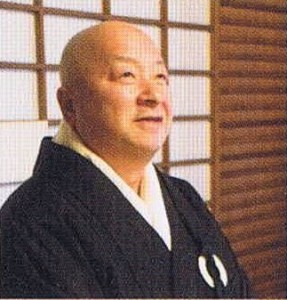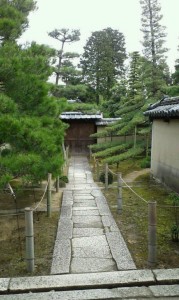Reiki, Aikido and Zen 3.
Soushou Yamada, chief priest of Daitoku ji, joined Hiroshi Doi and Koretoshi Maruyama at the Gendai Reiki International Conference 2012 in Kyoto.

Soushou Yamada at the Gendai Reiki Network International Conference 2012, in Kyoto
Earlier in the week, we had been treated to a special guided tour of Daitoku-ji, which is not normally open to the public. In the 14th century, Japanese priests went to China to train in Buddhism and one of them was the founder of Daitoku ji, which is a large walled temple complex and the head temple of the Rinzai sect school of Japanese Zen Buddhism. The complex has several subtemples, famous Zen gardens, and a tea room.
Shinju-an is a subtemple of Daitoku-ji, which was founded in 1491 for the memory of Ikkyu Sojun. The ink paintings of dragons and hermits on the sliding wall panels of three rooms of the Main Hall were painted in 1491; the paintings in the other two rooms were painted in 1601. The beautiful building had been a residence of a lady of the court of Emperor Ogimachi, and was transferred to Daitoku-ji from the Imperial Palace. Many parts of the temple are National treasures.
Master Yamada told us that at one stage the roof of Shinju-an was in poor repair and in winter the snowflakes on the floor sparkled just like pearls. Ever since then it has been called Shinju-an, which means the Pearl Hut.
The East Garden of the Main Hall is attributed to Murata Juko – who was the founder of the tea ceremony. The temple grew into a centre for the tea ceremony and became associated with tea master Sen no Rikyu. Master Yamada told us that Zen meditation has a lot to do with the tea ceremony.
We were invited to participate in Zazen meditation – sitting enlightenment meditation – led by Master Yamada, which was a tremendous privilege. Between the Zazen meditations, we engaged in silent walking meditation around Shinju-an, observing the simple beauty of the Zen gardens. The purpose of Zazen meditation is to calm the mind and body, in order to be able to concentrate enough to experience insight into the nature of existence and thereby gain enlightenment. Master Yamada instructed us regarding the correct posture to ensure that we could maintain deep and long breathing in order to calm our mind and bring fresh oxygen to our body.
To complete our experience, we shared Japanese green tea and conversation in the beautiful tea room.

Entrance to Shinju An Temple (The Pearl Hut)
At the Yui Conference, Master Yamada explained that the ‘Rei’ of Reiki is understood and used in Buddhism; it is the mystical power beyond human awareness. Everyone is a Buddha; the Buddha nature is in all of us, but we forget it. All beings contain the Buddha nature; mountain, tree, river, all is Buddha. The Buddha nature is called kami, but it doesn’t matter what we call it. All is one.
Everyday life is quite busy and unless you have a practice like Zen meditation, observing the breath, it can be difficult to get back to your centre. Copying the sutras is a spiritual practice in Japan, a form of meditation. In Japan, prayer is delivering your positive thoughts to the other party – rather than supplication.
When you keep doing your internal work you become light and happy, working towards satori, or enlightenment. When learning from your master, they pour from their vessel into your vessel. If you get to the level of your Master, you have only achieved half of what you are capable. You can’t learn the energy from other people; you need to experience it for yourself. Keep yourself humble and keep practicing and the way will reveal itself to you. We all have our own qualities to bring, which lead us to our unique pathway. How are you dealing with your life?
for more information go to: http://zen.rinnou.net/
Comments are currently closed.